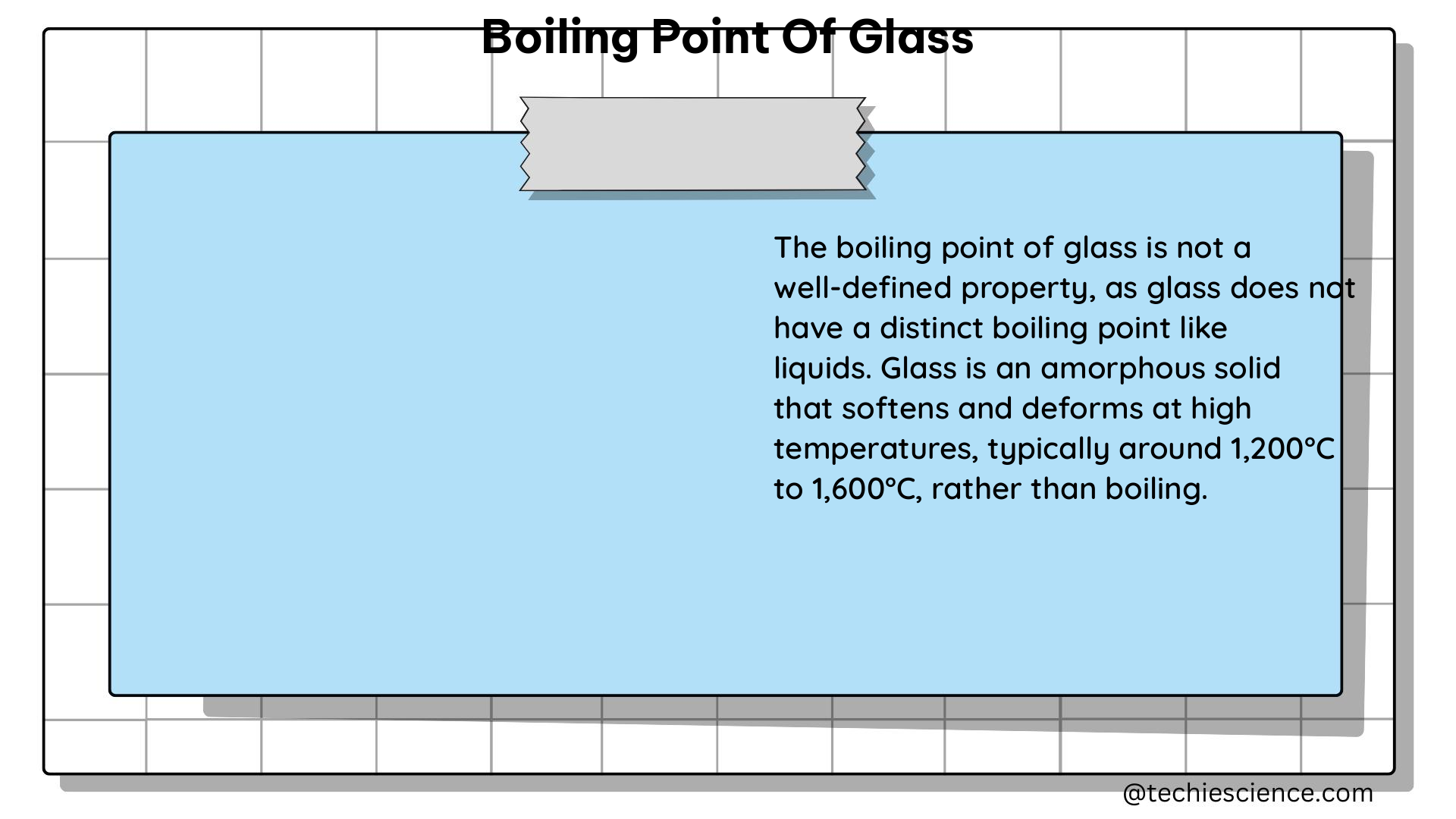The boiling point of glass is a complex and often misunderstood concept in the world of materials science. Unlike many other substances, glass does not undergo a traditional phase transition from liquid to gas at a specific temperature. Instead, glass exists in a unique state known as a supercooled liquid or a rigid liquid, which means it has a disordered solid-like structure but still retains the ability to flow. This unique property of glass makes the concept of its boiling point a challenging one to grasp.
Understanding the Melting Point of Glass
While the boiling point of glass is not a well-defined parameter, the melting point of glass can provide some useful insights. The melting point of glass is the temperature at which the glass transitions from a solid to a liquid state, and it is heavily dependent on the composition of the glass.
Soda-Lime Glass
Soda-lime glass is the most common type of glass, used in a wide range of applications such as windows, containers, and tableware. The melting point of soda-lime glass is typically around 1,500 degrees Fahrenheit (815 degrees Celsius).
Borosilicate Glass
Borosilicate glass, on the other hand, is known for its exceptional resistance to thermal shock and is commonly used in laboratory equipment, cookware, and certain types of lighting. The melting point of borosilicate glass is around 1,650 degrees Celsius (3,000 degrees Fahrenheit).
The Softening Point of Glass

In the context of glass technology, the softening point is a more relevant parameter than the boiling point. The softening point is the temperature at which the glass begins to soften and flow, and it is typically lower than the melting point.
The softening point of glass also depends on its composition, and it is an important factor in various glass-related processes, such as forming, shaping, and annealing. For example, the softening point of soda-lime glass is around 1,470 degrees Fahrenheit (798 degrees Celsius).
Theoretical Considerations
From a theoretical perspective, the boiling point of glass can be understood in terms of the intermolecular forces and the energy required to overcome them. In a typical liquid, the boiling point is the temperature at which the vapor pressure of the liquid equals the surrounding atmospheric pressure, allowing the liquid to transition into a gaseous state.
However, in the case of glass, the intermolecular forces are much stronger due to the disordered, rigid structure of the material. The energy required to overcome these forces and transition the glass into a gaseous state is significantly higher than the energy required for a typical liquid.
Numerical Examples
To illustrate the concept further, let’s consider some numerical examples:
- Soda-Lime Glass:
- Melting point: 1,500 degrees Fahrenheit (815 degrees Celsius)
- Softening point: 1,470 degrees Fahrenheit (798 degrees Celsius)
-
Boiling point: Not well-defined, as glass does not undergo a traditional boiling process.
-
Borosilicate Glass:
- Melting point: 1,650 degrees Celsius (3,000 degrees Fahrenheit)
- Softening point: Typically lower than the melting point, but specific values may vary depending on the exact composition.
- Boiling point: Not well-defined, as glass does not undergo a traditional boiling process.
Practical Considerations
From a practical standpoint, the boiling point of glass is not a relevant parameter in most glass-related applications. Glass is typically heated to its softening point or melting point, depending on the specific process being performed, such as forming, shaping, or annealing.
Attempting to measure the boiling point of glass in a DIY setting is not recommended, as it would require heating the glass to extremely high temperatures that can be unsafe and potentially damage the glass itself.
Conclusion
In summary, the boiling point of glass is a complex and often misunderstood concept in materials science. While glass does not have a well-defined boiling point like other substances, the melting point and softening point of glass are important parameters that depend on the composition of the material. Understanding these properties is crucial for various glass-related applications and processes.
References:
- OpenStax, “Phase Transitions: Melting, Boiling, and Subliming”, Introductory Chemistry, accessed June 17, 2024, https://opentextbc.ca/introductorychemistry/chapter/phase-transitions-melting-boiling-and-subliming/
- Pacific Northwest National Laboratory, “Glass Property Data and Models for Estimating High-Level Waste Glass Formulation Properties”, PNNL-18501, accessed June 17, 2024, https://www.pnnl.gov/main/publications/external/technical_reports/pnnl-18501.pdf
- Royal Society of Chemistry, “Predicting glass transition temperature and melting point of organic compounds”, accessed June 17, 2024, https://pubs.rsc.org/en/content/articlehtml/2022/ea/d1ea00090j
- LibreTexts, “Boiling Point”, Organic Chemistry Lab Techniques, accessed June 17, 2024, https://chem.libretexts.org/Bookshelves/Organic_Chemistry/Organic_Chemistry_Lab_Techniques_(Nichols)/06:_Miscellaneous_Techniques/6.02:_Boiling_Point/6.2B:_Step-by-Step_Procedures_for_Boiling_Point_Determination
- Glassedion, “Glass Melting”, accessed June 17, 2024, https://www.sciencedirect.com/topics/materials-science/glass-melting

The lambdageeks.com Core SME Team is a group of experienced subject matter experts from diverse scientific and technical fields including Physics, Chemistry, Technology,Electronics & Electrical Engineering, Automotive, Mechanical Engineering. Our team collaborates to create high-quality, well-researched articles on a wide range of science and technology topics for the lambdageeks.com website.
All Our Senior SME are having more than 7 Years of experience in the respective fields . They are either Working Industry Professionals or assocaited With different Universities. Refer Our Authors Page to get to know About our Core SMEs.